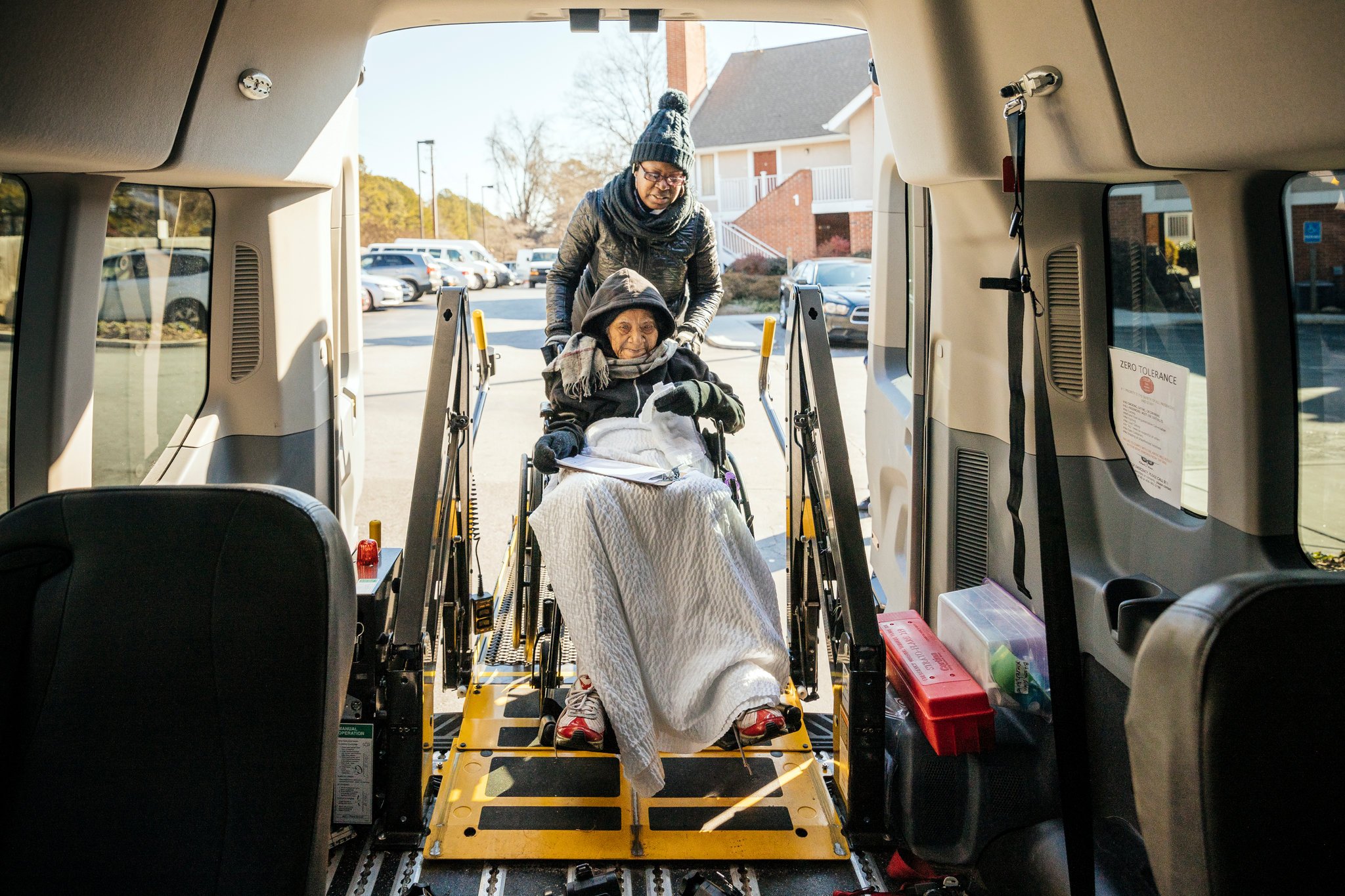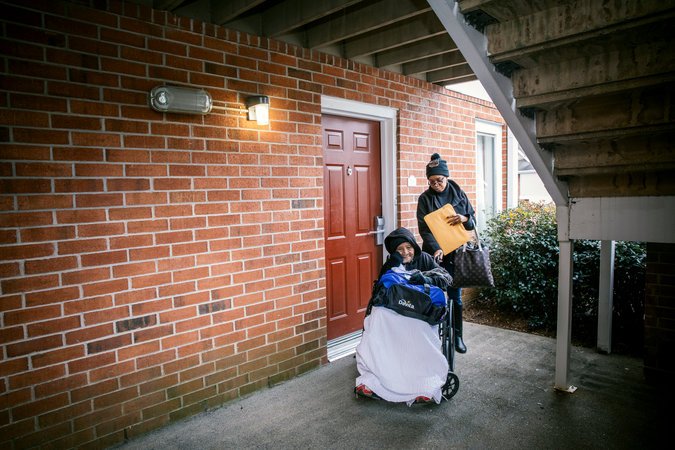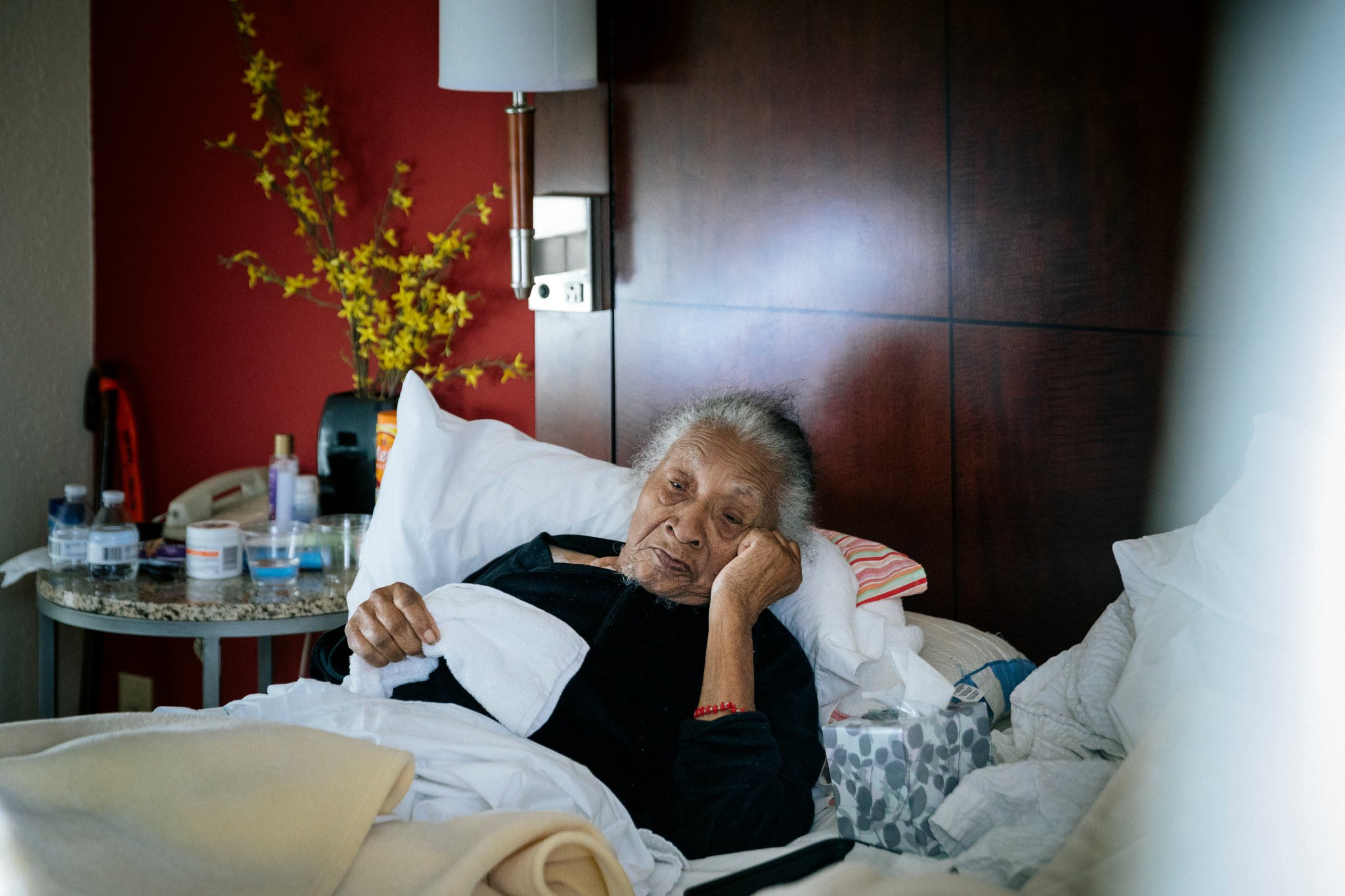 CHAMBLEE, Ga. — Juanita Edwards’s children, grandchildren and pets are waiting for her here on St. Croix.
CHAMBLEE, Ga. — Juanita Edwards’s children, grandchildren and pets are waiting for her here on St. Croix.
The Big Island’s air would be salty and familiar: Before the monster storms of 2017, she had never left the region.
But if she went home now, she would quickly die.
Edwards, 84, requires regular treatment for kidney failure, and the hurricanes that devastated the Virgin Islands last year crippled the territory’s ability to provide hemodialysis, the artificial blood-cleansing process that can substitute for faltering kidneys.
At least 200 dialysis patients like Edwards had to be evacuated last September from the territory to distant places where they could be treated — and they have been far from home ever since.
“It’s rough on her,” Gloria Edwards, Edwards’s daughter and primary caregiver, said as her mother dozed in the extended-stay hotel room they share in the Atlanta metropolitan area, where many of the evacuees remain. “She wants to go home. She wants to go home now.”
Federal health officials felt they had little choice, a decision reinforced as months have dragged on with halting recovery and little progress in restoring medical services in the Virgin Islands. “We don’t do paramedical evacuation often, and we certainly don’t do it on this scale,” said Capt. Charles Weir of the United States Public Health Service, who is a regional emergency coordinator in Atlanta with the office of the assistant secretary for preparedness and response.
“The only option for those dialysis clients was to find dialysis services elsewhere. Given that they’re U.S. citizens, that first option is us,” Weir said.
Many of the patients had to be evacuated repeatedly. At least 130 dialysis patients from St. Thomas and St. John were moved to Puerto Rico in the wake of Hurricane Irma in early September; as Hurricane Maria approached Puerto Rico two weeks later, around 100 of them were transferred to Florida, and then again to Atlanta. Maria’s development into a Category 5 storm that devastated St. Croix forced yet another hurried relocation. On Puerto Rico, which has more than 6,000 kidney failure patients, employees of the dialysis companies Fresenius and Atlantis worked with government officials to secure generators, fuel, water and supplies, restoring and maintaining services at most clinics throughout months of power failures across the island.
Juanita Edwards was evacuated on such short notice, Gloria Edwards recalled, that she only had time to pack three pairs of pants, two shirts, shoes and medication. She and her mother arrived at Dobbins Air Reserve Base near Atlanta in late September, part of an exodus that has tested both public and private resources.
“When you’ve got a population that’s moved, it’s really a whole community effort,” Captain Weir said. “The government has a role, the private sector has a role, community-based organizations have a role in providing all of the things that people impacted by disaster need.”
JUANITA EDWARDS IN ATLANTA
The dialysis patients in Atlanta, currently numbering 138, came as part of a larger federal program of medical evacuations that transported 531 patients from the Virgin Islands to the mainland for treatment, about half of them with an accompanying family member. Forty-one of the evacuated patients, many of whom arrived critically ill, have died, including 15 dialysis patients, who as a group often have other medical problems besides kidney failure.
The program, known as the National Disaster Medical System, has been used for years to transport hospital patients out of disaster zones for treatment in unaffected hospitals. They are usually returned home quickly afterward. But officials said that the dialysis patients from the Virgin Islands have presented new challenges, because of their continuing requirement for outpatient treatment and because medical care is only one of their many needs.
The situation is not without precedent. After the 2010 earthquake in Haiti, the same program airlifted patients from the Navy’s hospital ship Comfort to the United States for further care. Dozens of those medical evacuees were put up in Atlanta hotel rooms, and some, including Raymond Desir, a Haitian bricklayer who underwent surgery and rehabilitation for a severe hip fracture at Southern Regional Medical Center, remain in the Atlanta area today.
Many evacuees from last year’s storms have settled into an uneasy routine centered in Chamblee, a diverse city northeast of downtown Atlanta that hugs two interstate highways. Days punctuated by medical care — for Ms. Edwards, three rounds of dialysis a week, each lasting at least three hours — may offer little else but bouts of boredom, homesickness and ceaseless, and saddening questions about the future.
The Edwardses share a single bed in a room that has a stove, a refrigerator and a coffee maker. They spend many hours there, eating Chinese food, watching old Westerns, action movies and cartoons, and talking about decades past on St. Croix. On the day this winter that Gloria Edwards turned 52, her mother started talking about the precise time she had given birth — 1:05 p.m.
“If my mama was here by herself, she would break down more,” Edwards said. “She has me, she has God, she’s good to go.”
Edwards praised the efforts of emergency workers in helping her mother. But the process of making metropolitan Atlanta an evacuation site for the medically needy was marked by substantial hurdles and occasional missteps.
“They arrived in the middle of the night at the military base,” said Micheline Desse, a group facility administrator for DaVita, a dialysis company that has worked with the government. “They needed them to have dialysis the next day.”
Desse was asked to arrange care for 64 of the patients. She called every dialysis facility in her region to see how many could be accommodated; in many cases the answer was none.
She got better news from a clinic on Linden Avenue in Atlanta, within sight of the 55-story Bank of America Plaza that dominates the city’s skyline. The recently renovated clinic could take 40 patients. Staff members agreed to work longer hours and established an additional shift for dialysis.
But there were logistical problems. Some patients were placed in hotels far from their clinic, or would not be picked up on schedule, or would get back late and miss meals at their hotels. Patients had problems filling prescriptions. Federal officials serving brief rotations on the program were turned over frequently, and important information would sometimes be lost in the transitions.
There were also “struggles in the beginning, trying to meet the palate tastes of everyone,” said Jeanne Eckes, an Atlanta-based deputy health coordinator for the Department of Health and Human Services. “Lodging and dialysis was the priority. We gave them food, but it obviously wasn’t appropriate.”
Federal officials found themselves in unfamiliar roles, contracting chefs to cater to special medical diets with dishes that were also familiar to islanders; negotiating with hotels to obtain wheelchair-accessible rooms; and lining up drivers to ferry patients and their attendants to outpatient appointments. They arranged for the news-hungry islanders to hear radio stations from home streamed over the internet.
Many of the patients reached Atlanta with few belongings, so community groups donated clothing, especially for the unfamiliar winter weather. The American Red Cross provided pre-loaded debit cards so patients and caregivers could buy food to prepare in their hotel kitchenettes. Employees of the Federal Emergency Management Agency (FEMA) and Medicare, which contracts with the Kidney Community Emergency Response program, also provided assistance.
Some of the most difficult needs to meet, though, have been psychological.
“These people want to go home,” Eckes said.
It is a subject the Edwardses discuss often. Juanita Edwards is eager to return to the island, while her daughter is hoping to stay in Atlanta permanently.
“I am so comfortable here, I’m at ease — new faces, and I’m going to have a new life,” Gloria Edwards said. “I pray for them to go home safely and live again, but I’m not living there. There’s nothing that will make me stay in St. Croix.”
Juanita Edwards weeps at the thought of never returning to Christiansted.
But it is not clear when she will be able to go back. Before the storm, there were just two main dialysis clinics in St. Croix. Treatment at a dialysis center requires clean water, reliable electricity, trained staff, and, because the procedure typically involves tapping into major blood vessels, the ability to transport a patient swiftly to a functioning hospital for emergency care if something should go wrong. It is a hard bill to fill now on St. Croix.
Medical services in the Virgin Islands are still severely hobbled, with hundreds of staff members laid off from damaged hospitals, many types of specialty care unavailable, and emergency rooms overflowing. Modular hospital units have been ordered but will take months to arrive, and even temporary dialysis trailers and portable operating rooms are not expected for several more weeks.
“Right now, for any individual that has a high acuity health problem, we have to evacuate them off the island,” said Michelle Davis, the Virgin Islands health commissioner. She said some patients had returned home only to be re-evacuated. “It’s way too much on the patient in terms of the stress,” she said.
So the Edwardses must wait.
“It’s a lot of work,” Gloria Edwards said. “It’s stressing. It’s frustrating. It’s tiring, depressing, everything. But there’s no other choice.”
GLORIA EDWARDS IS OVERCOME WITH EMOTION
(TO READ MORE FROM THE NEW YORK TIMES):
https://www.nytimes.com/2018/02/17/us/virgin-islands-hurricanes-dialysis-patients.html



